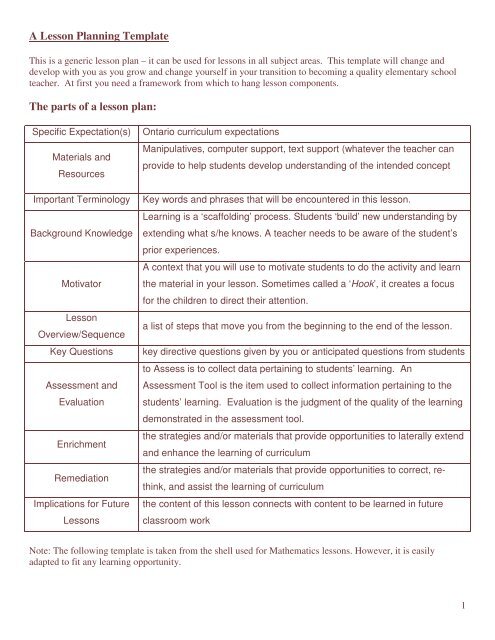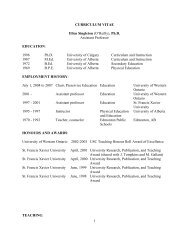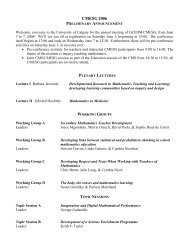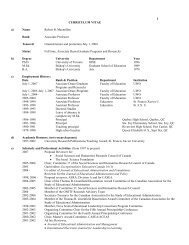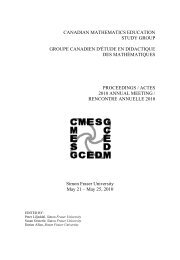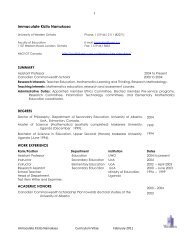Lesson Plan Template Grade 8 Fractions - Publish
Lesson Plan Template Grade 8 Fractions - Publish
Lesson Plan Template Grade 8 Fractions - Publish
Create successful ePaper yourself
Turn your PDF publications into a flip-book with our unique Google optimized e-Paper software.
A <strong>Lesson</strong> <strong>Plan</strong>ning <strong>Template</strong><br />
This is a generic lesson plan – it can be used for lessons in all subject areas. This template will change and<br />
develop with you as you grow and change yourself in your transition to becoming a quality elementary school<br />
teacher. At first you need a framework from which to hang lesson components.<br />
The parts of a lesson plan:<br />
Specific Expectation(s)<br />
Materials and<br />
Resources<br />
Important Terminology<br />
Background Knowledge<br />
Motivator<br />
<strong>Lesson</strong><br />
Overview/Sequence<br />
Key Questions<br />
Assessment and<br />
Evaluation<br />
Enrichment<br />
Remediation<br />
Implications for Future<br />
<strong>Lesson</strong>s<br />
Ontario curriculum expectations<br />
Manipulatives, computer support, text support (whatever the teacher can<br />
provide to help students develop understanding of the intended concept<br />
Key words and phrases that will be encountered in this lesson.<br />
Learning is a ‘scaffolding’ process. Students ‘build’ new understanding by<br />
extending what s/he knows. A teacher needs to be aware of the student’s<br />
prior experiences.<br />
A context that you will use to motivate students to do the activity and learn<br />
the material in your lesson. Sometimes called a ‘Hook’, it creates a focus<br />
for the children to direct their attention.<br />
a list of steps that move you from the beginning to the end of the lesson.<br />
key directive questions given by you or anticipated questions from students<br />
to Assess is to collect data pertaining to students’ learning. An<br />
Assessment Tool is the item used to collect information pertaining to the<br />
students’ learning. Evaluation is the judgment of the quality of the learning<br />
demonstrated in the assessment tool.<br />
the strategies and/or materials that provide opportunities to laterally extend<br />
and enhance the learning of curriculum<br />
the strategies and/or materials that provide opportunities to correct, rethink,<br />
and assist the learning of curriculum<br />
the content of this lesson connects with content to be learned in future<br />
classroom work<br />
Note: The following template is taken from the shell used for Mathematics lessons. However, it is easily<br />
adapted to fit any learning opportunity.<br />
1
A <strong>Lesson</strong> <strong>Plan</strong> – <strong>Grade</strong>s JK – 8<br />
Teacher: Sharon Miller <strong>Grade</strong>: 8_<br />
(A.) Specific Expectation(s): Strand: Number sense and Numeration- represent the multiplication of<br />
fractions, using a variety of tools and strategies, (e.g. using an area model)<br />
(B.) Materials and Resources: “ Math Makes Sense” ( Addison Wesley) Pages 149, 150<br />
(C.) Important Terminology:<br />
Numerator<br />
Denominator<br />
Important Terminology:<br />
Proper and Improper <strong>Fractions</strong><br />
Congrugent Rectangles<br />
(D.) Background Knowledge:<br />
- students know how to use area models to<br />
multiply 2 whole numbers, and to multiply a<br />
whole number and a fraction<br />
(E.) Motivator: (Exploratory Activity) Choose a partner.<br />
¼ of a cherry pie was left after dinner. Trevor ate ½ of the leftover pie for lunch the next day.<br />
(a) What fraction of the pie did he have for lunch<br />
(b) What if Trevor had only eaten ¼ of the leftover pie What fraction would he have eaten<br />
How will you solve this problem<br />
Motivator:<br />
(F.) <strong>Lesson</strong> Overview Whole Class:<br />
1. Do Area Model example on Volleyball team question- ( Transparency of Page 149)<br />
2. Partner Assignment:- Page 150, Questions 1 and 2.e.g. Draw a rectangle on grid paper to find each<br />
product. ½ x ¾, ¾ x 5/8 Each partner will do every other question and check each other`s work.<br />
3. Individual Assignment- Question 4 on Page 150. Draw area models to find each product. E.g. ¾ x 2/5<br />
4. Reflections in Math Journal: When you use an area model to multiply two fractions, how do you<br />
decide to draw the rectangle Include an example in your explanation.<br />
Enrichment:<br />
Remediation:<br />
2
(G.) Evaluation☹Assessment)<br />
Use a class list to check understanding of area models, and multiplication of proper fractions.<br />
(H.) Enrichment: Game: You need a spinner<br />
with fractions in each part of the circle.<br />
For each turn, players spin twice. Player A<br />
adds the fractions. Player B multiplies the same<br />
2 fractions. Player with the higher result gets 1<br />
point. First player with 12 points wins.<br />
(J.) Implications for Future <strong>Lesson</strong>s: Next Steps:<br />
Use area models to represent the product of improper fractions.<br />
Introduce the standard algorithm to multiply proper and improper fractions.<br />
(I.) Remediation: - Individual or small-group<br />
assistance for students experiencing difficulty<br />
with drawing area models<br />
3


